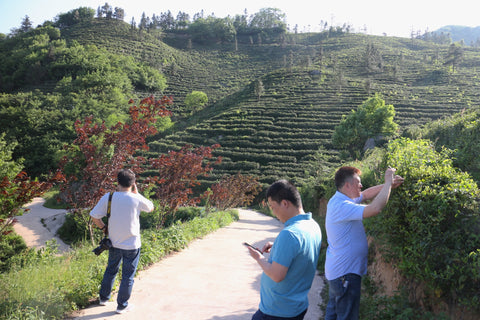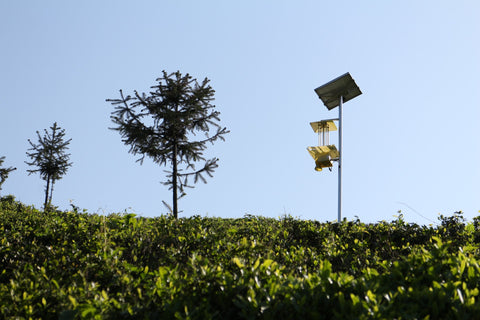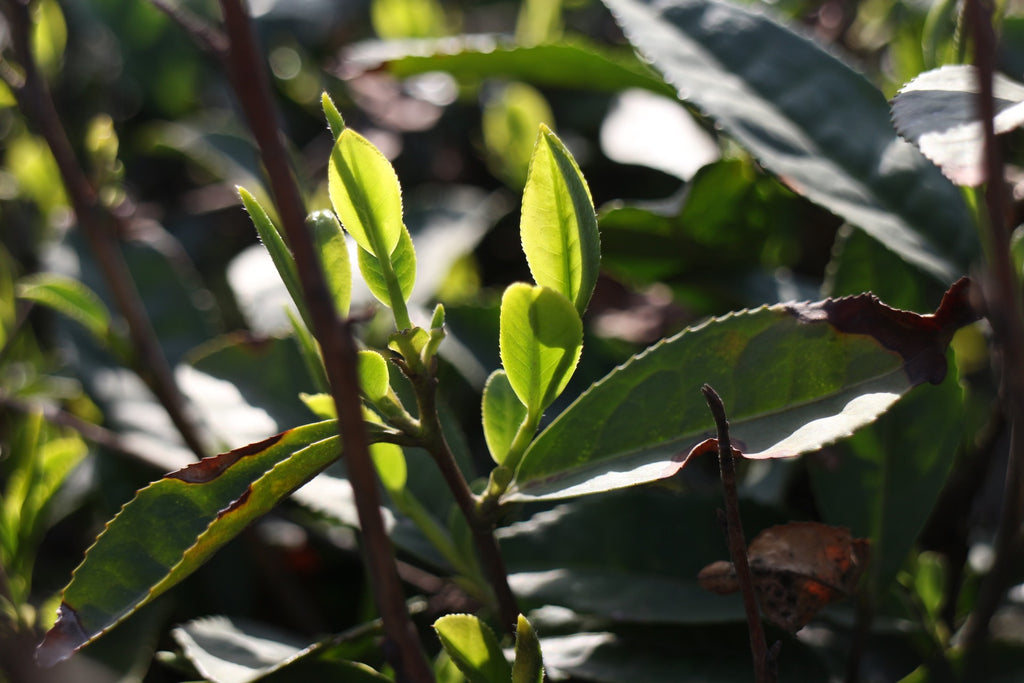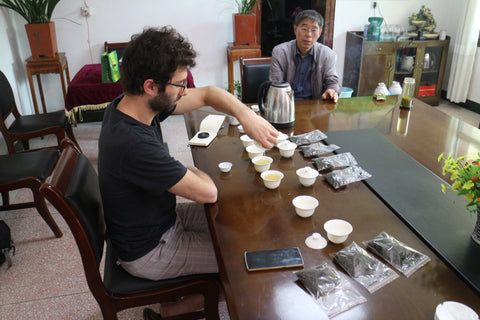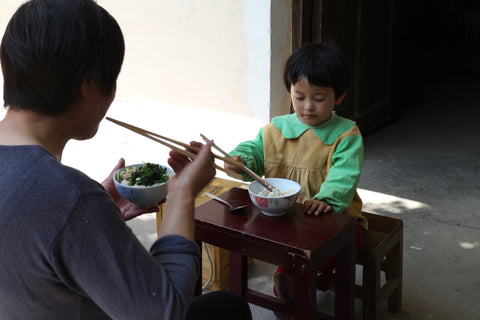A Tea Garden Without Pesticides, Herbicides, or Chemical Fertilisers
Zhengzhou, 19 April 2018
After a few days in the city, I feel the call of nature. In the southeast of Henan, along the border with Anhui, lies a mountain range stretching more than a hundred kilometres. Along the entire length of its slopes are plantations of the renowned local green tea, Xinyang Maojian; among all of the different producers, it is difficult to choose whom to visit.
The plantations can be divided into two large categories: the majority are made up of young plants, obtained, as is common in agriculture, through genetic improvement (cultivars). Some gardens, however, additionally have wild varieties grown from seed; these are designated by the Chinese term Cai Cha, literally "vegetable tea".
Yesterday, I did a comparative tasting of the two categories, and preferred the Cai Cha. Besides, these gardens are rarer and natural, one more reason to visit one of them.
Five hours by car, almost all motorway, and here we are at our destination. The proprietor of the family-owned company inherited his tea fields from his father. Their tea garden, on top of a hillock, is not large, but well cared for. The seeds were planted in the '50s and '60s; a green tea from plants more than half a century old: another rarity! The journey is growing more and more interesting.

Breakfast in the canteen of a customs house. After two photos, they politely asked for the camera to vanish.
New motorway, with European standards, but deserted.
Mountain village; main road.
The proprietor tells us he has obtained a state subsidy to buy a new machine for processing the leaves: an infrared oven, which seems to be the latest fashion among the Xinyang farmers. The leaves, rather than being heated in a rotating wood-fired oven, will be subjected to infrared light while they run through a conveyor belt. In less time, and with much less work, it deactivates the enzymes which cause oxidation in the leaves.


Leaves cooked in a wood-fired oven (left) and in an infrared machine (right). The leaves heated with infrared light remain a brighter green.
On the left, the new infrared machine. On the right, the classic rotating wood-fired oven.
We visit the tea garden just before sunset. The tea plants grow among alternating small firs, bamboo, ginkgo and peach trees; weeds and vines grow around the bases. Biodiversity is always a good sign, indicative of a natural agriculture. One of the main reasons we chose to come to this garden is the total renouncement of pesticides, herbicides, and chemical fertilisers. The owner is very proud of this, and shows us the lamps (which I would see in operation after sunset) and coloured adhesive sheets, strewn among the rows of bushes, to attract insects. Such natural plantations are quite rare; even organic tea gardens rarely give up the use of pesticides and other chemical substances completely.

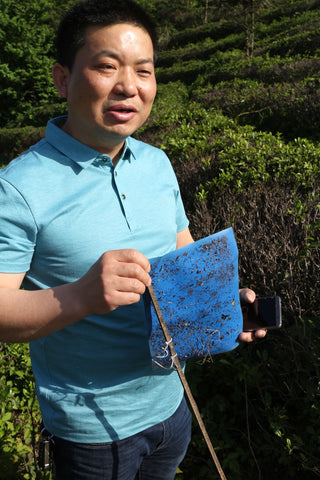
Tea garden at sunset.
Lamps and coloured adhesive sheets to attract insects.
Freshly opened tea leaflets.
Zhengzhou, 20 April 2018
In the afternoon, I taste the tea produced in the past few days. We are quite far to the north here, and the harvest has only started on the 30th of March, much later than the other famous teas like Long Jing and Biluochun. In addition to the date of harvest, the different teas are also distinguished by the size of their leaves, xiao ye (little leaves) or da ye (big leaves). Also, one of the teas, harvested on April 12, comes from bushes on the mountain's summit. Obviously the prices vary: more expensive for littler leaves and those from the first days of the harvest.
I am not the only one tasting tea, but am in the company of a television crew, who have come to film a documentary on Xinyang Maojian. The stranger come from far away is the recipient of curiosity and interest. So, after the tasting, I do my first ever interview in Chinese! My Chinese, little more than rudimentary, provokes mirth; everyone laughs, including the cameraman; but at least I am understood.
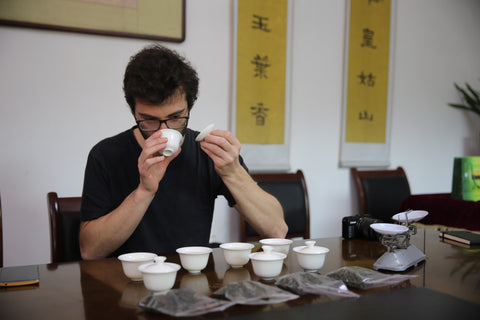
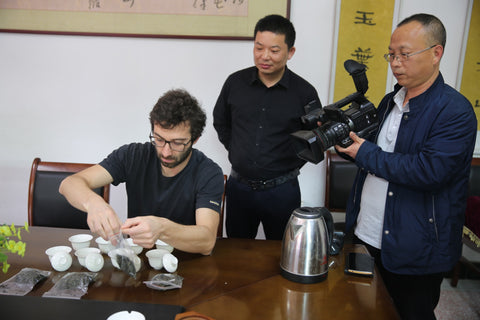

Tea tasting in front of the camera and being interviewed for a documentary for Chinese television.

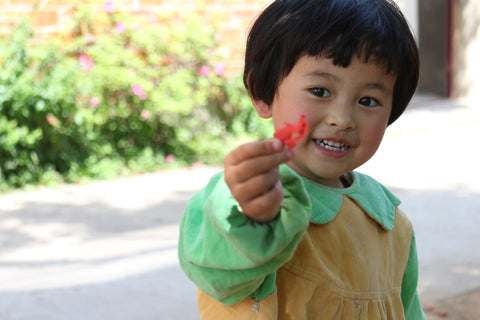
Family lunch.
The kitchen. A girl offers me a gift.
The teas picked during the first week are quite similar; from March 31st to April 6th, the price decreases considerably, but the quality stays relatively consistent. The tea from the following weeks, on the other hand, are much less fresh and bitterer; the mouthfeel (kou gan in Chinese) is also less soft and velvety.
The prices, in general, are a bit high. But I have to consider that, by completely renouncing the use of pesticides and chemical fertilisers, the harvest is much less bountiful. Taking advantage of the sympathy and the help with the documentary, we manage to negotiate a discount for the best tea, from April 6th.
We take a last stroll through the tea garden before getting back in the car to return to Zhengzhou, where we arrive late at night.

Among the tea bushes.
The proprietor explains to us that the tea garden on the back was entirely created by his father, who worked every day and moonlit night removing trees, clearing the soil, and planting seeds.
The mountains in the distance lie in Anhui, right where Lu'an Gua Pian and Huoshan Huang Ya, well-known green and yellow teas, are produced.
The sojourn in the north is over. Tomorrow, I fly to Anxi, in the south of Fujian, to visit some Tieguanyin producers; totally new contacts, from individual farmers to medium-sized companies, all with one common feature: sustainable organic agriculture.
Written by Gabriele





